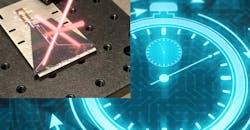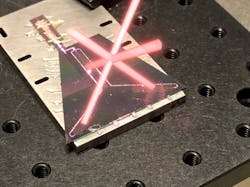Robust Atomic Clocks Miniaturize Timekeeping
Timekeeping is an important element of many modern commercial and military electronic systems, and DARPA has paid much attention to trimming the size and power consumption of atomic clocks. Although these oscillators are renowned for their high frequency accuracy, they have traditionally been bulky with high power requirements. Chip-scale atomic clocks (CSACs) meet many of the size, weight, and power (SWaP) requirements of mobile, portable commercial, and defense electronic systems wile providing outstanding frequency and time stability under a wide range of operating conditions.
DARPA’s efforts in developing atomic clocks with enhanced stability (ACES) have resulted in smaller, lower-power atomic clocks suitable for mobile applications. As Dr. John Burke, the program manager for DARPA’s ACES Microsystems Technology Office (MTO), explains: “Shrinking atomic clocks from large cesium beam tubes to chip-scale devices without eroding performance requires a rethinking of a number of critical components, including vacuum pumps and optical isolators as well as new approaches to component integration.”
The light pattern shows the laser beams generated by an electro-optical atomic clock designed to provide high frequency accuracy with low power consumption for mobile electronic time-keeping applications. (Courtesy: Honeywell)
Burke adds: “The target metrics we outlined for the ACES program are lofty, but as we enter the third phase of the program, researchers are already demonstrating engineering successes including reduced SWaP, lab-proven atomic clock technologies, as well as early prototypes of future clock architectures.”
A team of researchers from the National Institute of Standards and Technology (NIST), with support from researchers at the California Institute of Technology, Stanford University, and Charles Stark Draper Laboratories, recently demonstrated an optical atomic clock based on a trio of miniature low-power electro-optical integrated circuits (ICs). The time-keeping device functions at higher frequencies than standard RF/microwave atomic clocks, making possible the dramatic miniaturization. NIST’s experimental optical atomic clock uses a laser to track rubidium (Ru) atoms in a vapor cell or glass container that is only 3 mm across mounted on a silicon (Si) IC. The Ru atomic clock provides enhanced frequency and timing accuracy compared to cesium (Cs) atomic clocks while consuming only 275 mW power.
The NIST researchers are being supported by additional research teams at Honeywell in partnership with the University of California at Santa Barbara and a research team from NASA’s Jet Propulsion Laboratory (JPL).
About the Author
Jack Browne
Technical Contributor
Jack Browne, Technical Contributor, has worked in technical publishing for over 30 years. He managed the content and production of three technical journals while at the American Institute of Physics, including Medical Physics and the Journal of Vacuum Science & Technology. He has been a Publisher and Editor for Penton Media, started the firm’s Wireless Symposium & Exhibition trade show in 1993, and currently serves as Technical Contributor for that company's Microwaves & RF magazine. Browne, who holds a BS in Mathematics from City College of New York and BA degrees in English and Philosophy from Fordham University, is a member of the IEEE.


